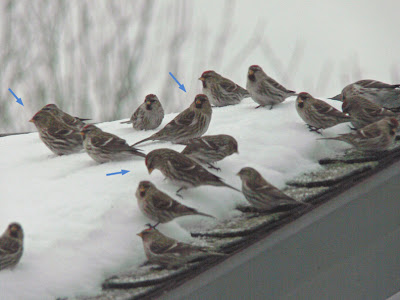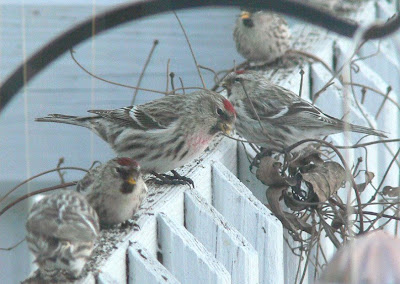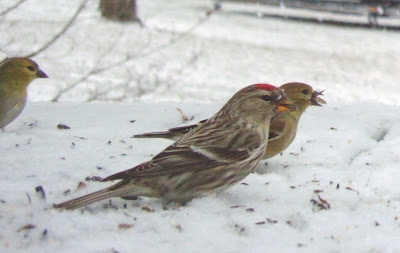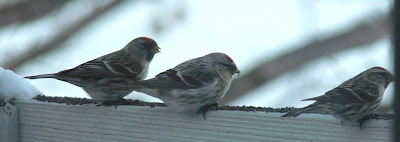Maybe we are just more aware and looking harder for “Greater” Common Redpolls (Carduelis flammea rostrata) this winter in Massachusetts, or maybe it’s really an exceptional winter, but there is no doubt that they have come south in significant numbers. I have seen them on a couple of visits to Dan Berard’s feeders in Millbury, MA, where he has been studying redpolls almost daily since December. This has confirmed yet again Yogi Berra’s comment that “You can observe a lot by just watching”.
This subspecies is relatively poorly-known, nesting on Baffin Island and Greenland and wintering irregularly south to the northeastern US. Literature on identification of this subspecies (Beadle and Henshaw 1996; Herremans 1990, Knox 1988, Pittaway 2007) characterizes it as a consistently large and dark bird. Based on those studies and comments from Dan Berard I’ve put together a list the features that distinguish rostrata from “Southern” Common Redpoll C. f. flammea, listed in order (my judgment) from most important to least important:
- averaging 10% larger and about 50% heavier
- Generally more heavily streaked below (more streaks and wider streaks); blurry streaks extending along flanks to undertail coverts, which average darker than flammea; at least some individuals are more heavily streaked than any flammea Common. Some have the flank streaks converging into a solid dusky patch at the rear end of the flanks.
- Some in MA (as on most specimens here) have a complete necklace of fine streaks below the dark throat patch, which is very distinctive if present.
- At least some have whole face darker, more streaked, with only faint pale eyebrow stripe, and densely streaked malar. These are probably the same birds with the necklace of streaks, very heavy dark flank streaking, and rich brown color, but even on some of the less obvious individuals a general dusky-headed appearance is evident.
- usually appears longer-tailed
- bill may appear thicker with curved culmen
- darker and more richly-colored brown overall
- often looks thick-necked and “front-heavy”
- some have more extensive dark throat patch
- male typically has less red on breast and lacks red on malar
- Dan Berard reports that he often hears distinctly different “harsher, more rattling” calls when Greaters are present, although he hasn’t yet confirmed that these sounds come from the Greaters.
Here’s a photo of a flock of redpolls with several large dark birds:
 photo copyright Dan Berard, used by permission – click to enlarge. Sharp-eyed readers will notice that the top right bird is quite pale, but unfortunately we can’t do much more with that.
photo copyright Dan Berard, used by permission – click to enlarge. Sharp-eyed readers will notice that the top right bird is quite pale, but unfortunately we can’t do much more with that.
Three rostrata “Greater” redpolls are fairly obvious here (blue arrows), being larger and darker than the birds around them. And several others are possibly “Greater” but not quite dark enough or large enough to be identified confidently. Features that seem to be especially useful for picking out these birds are the darker head and broader, blurrier streaking on the flanks than other redpolls, but this is not always consistent. Size is the most consistent feature for identifying this subspecies, but one of the first things you notice when you start looking for larger redpolls in a flock is that size is surprisingly difficult to judge (impossible without direct comparisons) and there seem to be some birds that are intermediate in size. Measurements (e.g. in Herremans 1990, Knox 1988, Knox and Lowther 2000) confirm that rostrata and flammea overlap in all measurements, even though the average is significantly different. So I guess it’s not surprising that we would see a full range of size from small to large, and it leaves the question – “when is a bird large enough to qualify as rostrata?”
A side note on psychology and perception – This leads to yet another manifestation of the ambiguity issues that I wrote about previously for White-fronted Geese. Because redpoll identification involves subjective judgment of ambiguous variations in color and size, the first few redpolls you look at can set a standard that persists as you scan the rest of the flock. You can scan a flock once and find a dozen that look like candidates for ‘Greater’ (or Hoary), then scan the same flock seconds later and find no good candidates!
The other interesting observation about rostrata ‘Greater’ Redpolls is that they may not be as consistently dark as the literature leads us to believe. Here’s a male that is quite pale and grayish, not the heavily-streaked and richly-colored plumage that is considered typical of “Greater”. But given that it’s an adult male the overall color is within the range of Common Redpoll, and the flank streaking pretty heavy for an adult male.
 photo copyright Dan Berard, used by permission – click to enlarge. The bird just behind the “Greater” in the center (facing left) is a possible Hoary, so that should be considered when comparing colors.
photo copyright Dan Berard, used by permission – click to enlarge. The bird just behind the “Greater” in the center (facing left) is a possible Hoary, so that should be considered when comparing colors.
Among the large redpolls in Millbury, we’ve seen a few large birds (non-adult-males) that are paler than the typical flammea Common redpolls (in at least some respects).
Here’s a picture of one such bird:
This bird is one of several seen that day that were obviously large (larger than the goldfinch), and that also stood out among the flock of Commons by their pale overall color, with pale and grayish back and pale head. It also had a pale, but faintly streaked, rump. One thing that still points toward rostrata “Greater” Common is the broad blurry streaks on the flanks, and presumably the undertail coverts were also streaked, so maybe this is within the normal range of variation of rostrata, but the overall paleness is not what I expected.
And here’s an even paler bird (I wish I had seen this one in life):
This picture may include three subspecies: rostrata “Greater” on the left, a good candidate for hornemanni Hoary in the middle, and an ordinary flammea Common on the right. The middle bird seems about as large as the rostrata on the left, and larger than the flammea at the right. It’s very pale overall, and compared to the pale rostrata-types such as in the previous photo it has a paler nape with less distinct streaks, white flanks with narrow dusky streaks, mostly white undertail coverts, smaller bill, and smaller black throat patch. It’s just not quite as white and unstreaked as I expected the “classic” hornemanni to be.
Conventional wisdom holds that rostrata “Greater” Common Redpolls are large and dark, and that hornemanni or “Hornemann’s” Hoary Redpoll are equally large and very pale. So I have always assumed that the two would be easier to tell apart than the smaller “Southern” flammea Common and exilipes Hoary Redpolls. But the large birds we’ve seen in Massachusetts this winter do not all fit the model. At the feeders in Millbury the large birds show a wide range of color variation, from very dark (classic rostrata) to quite pale (but so far none of the very pale classic hornemanni color).
Are rostrata “Greater” Commons more variable than previously thought with some relatively pale individuals? It appears so. But how close can they get to hornemanni Hoaries? And are hornemanni just as variable? Knox (1988) says that female and immature hornemanni can match exilipes in plumage, so can some individuals be relatively dark like the darker Hoaries we’ve been talking about this winter? Knox (1988) mentions one mixed pair of rostrata and hornemanni from Greenland. He found no other convincing evidence of hybridization, but it is still possible that these two large subspecies are interbreeding, producing a whole range of intermediate plumages. Any or all of these scenarios are possible. The only thing that seems clear is that the plot has thickened, questions abound, and identifying these large redpolls may be more challenging than we thought.
Thanks to Dan Berard for permission to use his photos, for hosting the birds and the birders, and for discussions about redpoll identification.
References:
1996. Identification of “Greenland” Common Redpoll Carduelis flammea rostrata . Birders Journal 5: 44–47.
1990. Taxonomy and evolution in redpolls Carduelis flammea-hornemanni ; a multivariate study of their biometry. Ardea 78: 441–458.
1988. The taxonomy of redpolls. Ardea 76: 1–26.
Knox, Alan G. and Peter E. Lowther. 2000. Common Redpoll (Carduelis flammea), The Birds of North America Online (A. Poole, Ed.). Ithaca: Cornell Lab of Ornithology; Retrieved from the Birds of North America Online: http://bna.birds.cornell.edu/bna/species/543
Pittaway, R. 2007. Redpoll Challenge: 4 subspecies. Online http://www.jeaniron.ca/2007/Redpolls/redpolltext3.htm




Phenomenal post! I had not heard of “Greater” Common Redpolls, here in Illinois we are ecstatic just for the regular Common Redpolls 🙂
Thanks for all the great information you provide on this blog and good birding to you!
Hi Birdfreak,
Thanks, I’m glad you enjoy the info. Actually, anywhere in eastern North America is within the potential range of “Greater” Common Redpolls. They showed up in Toronto last November, there are records from Ohio, and I recently saw photos of a good candidate from Wisconsin. The BNA account even says the subspecies has been recorded in Colorado! (I’ll take that with the proverbial salt grain until I know more about it). But if you’re seeing Common Redpolls in Illinois, you should keep checking them for larger birds.
Very informative readings about Redpolls and the possible hybridisation of rostrata and hornemanni . One such possible cross was in my backgarden (in sw-Iceland) few days ago. I would be interested to know what you think of it . : http://www.flickr.com/photos/omarrun/5624054748/
Thanks for your great work and your blog !
Omar
We have what appears to be a Hoary Redpoll here. He or she is much larger, lighter and friendly than the rest of the flock.
Sorry, forgot to mention I am in north, central Pennsylvania.
That sounds good for Hoary on all three counts, but could also be explained by a Common that is ill (which would be slower and less wary, with feathers fluffed up making it look bigger and paler). I’d be happy to look at photos if you have can send any.
Best, David
Excellent